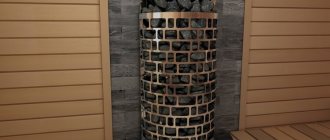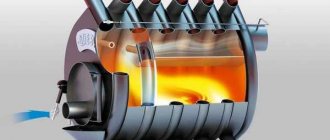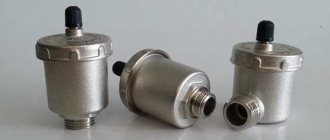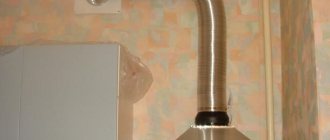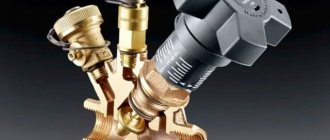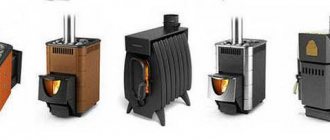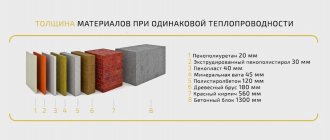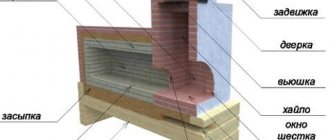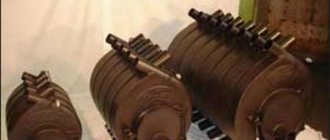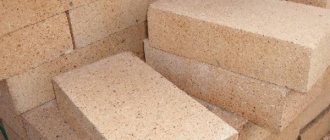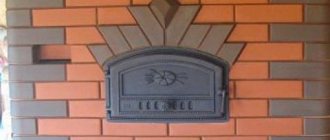Types of grate
Material
The temperature in the furnace is quite high, which forces craftsmen to make grates from special metals:
- The most durable is a cast iron oven grate.
- There are also steel parts, the most popular of which is antipyretic steel. Such grates are not susceptible to oxidation and corrosion when the flame burns, and also do not deform. These devices can have different sizes and shapes, the abundance of which makes it possible to choose a grate even for a non-standard stove model.
Example of a grate for a furnace
Solid and stacked
For convenient use, you can choose different grate designs:
- Solid. They look like monolithic gratings; they cannot be broken down into smaller components. Most manufacturers have standard oven grate sizes, focused on the most popular oven models. The choice of sizes of solid parts is quite large. Preference should be given to a certain product taking into account the fuel surface area.
- Stacked grates. They have a collapsible shape and can be assembled independently. The number of their components depends on the required area of the device. This guarantees their versatility, because the oven grate can be made in any size and is suitable for non-standard ovens.
Fixed
Fixed devices are grilles that do not move.
Subtypes of fixed grate:
- tiled flat, the most popular;
- basket, rarely used;
- beam
Tiled - these are rectangular-shaped parts and are the most popular. They can be used for any model, they are universal and easy to install. The stores offer a huge selection of grates of this particular type.
Basket grates are not very popular, because they are used for open ovens. In the old days, they were components of ovens on which food was cooked. Nowadays gas and electric stoves are used for this.
Beam gratings visually resemble a construction beam. They are assembled only by hand. Consumers like them for their versatility and the ability to install them in any oven.
Movable
Subtypes of movable grate:
- full-rotary;
- swinging;
- chain
Movable furnace grates consist of several parts. These include sections and shaft. Thanks to the possibility of rotation, the process of cleaning ash is simplified. Movable gratings are divided into full-rotating and swinging: the angle of inclination of the first is 180 degrees, the second can rotate from 30 degrees. Another type of such gratings is chain. In its design, the elements are connected to each other by chains. The disadvantage of this type of grate is the incomplete combustion of wood or coal.
Specifications
A structure of any size can be assembled from beam grates.
Depending on the type of fuel used and the design of the boiler, the grate bars are made of monolithic parts or hollow pipes. The latest models are air-cooled, which reduces the likelihood of metal melting. The shape and size correspond to the firebox of the appliance and the door configuration through which they must pass during installation.
The following types of grates can be installed in ovens:
- Tiled. They are a rectangular product with parallel crossbars. They are universal, as they have different intervals for all types of fuel.
- Baskets. Products with a volumetric configuration that is effective but difficult to maintain.
- Beam. They are set parts from which grates of any size and configuration can be assembled. They are used in self-manufacturing of boilers for assembling non-standard grates.
The correct choice of grate is as important as the chimney, damper and vent. Every detail is important in making a boiler.
Dimensions
Another condition for choosing a grate for a stove is its length and width. The sizes of the grate for the furnace are different, they are determined by the type of fuel:
- For light firewood or briquettes, grates from 140x120 mm to 330x252 mm are sufficient.
- For coal, larger parameters are needed: 300x300, 350x300, since this fuel emits a large amount of harmful substances when burned.
Variety of grate sizes
What is a grate for?
This important element of the furnace combustion chamber allows you to get the maximum effect from fuel combustion. The structure of modern stoves is constantly being modified and improved, and only the main structural element of the firebox remains unchanged. The combustion equipment retains its grate configuration.
The platform supports any type of solid fuel (firewood, coal and briquettes). Through the through openings, air is sucked in from below, which creates effective draft inside the combustion chamber. Combustion products (ash) fall into the ash pan (ash pan), freeing up space for the top layer of fuel. The grate promotes uniform combustion of fuel, thereby achieving maximum thermal energy transfer from the fuel placed in the combustion chamber.
Buying tips
For high-quality combustion, not only the size of the grate is important, but also the weight of the fuel that it can withstand in one laying. The rods should not deform or wear out.
The grate must have a sufficient number of holes - at least 40% of the area of the part itself. If this figure is lower, then there will not be enough oxygen to maintain the fire, and the ash will remain on the grate and clog the stove.
If the gaps in the grate have a large area, then the remaining fuel will fall from the combustion chamber into the ash pan. Fuel consumption will become uneconomical.
Optimal lattice option
Choosing the right grates
To choose a specific model, you need to consider the type of fuel. which is planned to be used most often . For example, for coal, a design with dimensions of 350-300x205 mm . for briquettes or firewood, it is better to determine the size frame 140x120 - 330x252 mm. The grate must be selected in such a way that it can support the maximum weight of a single load of fuel .
To determine the maximum weight, it is best to seek advice from a qualified dealer. To avoid problems with cleaning ash, the gaps should be at least 40% of the area of the overall structure .
If the specified proportions are not observed, the installation of the furnace will not be as effective, due to the fact that the volume of supplied air will be insufficient for the combustion intensity . In addition, insufficient ventilation can lead to the accumulation of gases, which should not be allowed under any circumstances. If the area of the gaps is made larger, then unburned fuel residues .
What is needed for production?
It is possible to make a grate with your own hands. What to make a grate for the oven from? It is better to use heat-resistant steel as a material, because it is impossible to work with cast iron at home. To make the grille, you can use any materials that have heat-resistant characteristics. This could be fittings, corners, steel pipes or strips of metal.
To make grate bars you will need:
- the metal from which the grille will be made,
- steel rods for creating partitions;
- ruler, tool for making marks;
- grinder for cutting material;
- welding.
What types of grate designs are there?
If we talk about products made of heat-resistant steel, then there are pipe and chain varieties of grates.
As for cast iron grates, there are several types:
- Tiled . Such rectangular grates are widely used in solid fuel stoves and boilers, fireplaces. We can say that these are universal products. You just need to choose the right grate size.
- Baskets . This type of grate was used in open hearths where food was prepared. Currently, they are practically never found.
- Beam . Externally, such grates resemble beams for construction. They are single or double stacked parts from which you can build a grill of any size.
- Movable gratings . The peculiarity of this design is that the grille links can be moved in a horizontal plane, changing the clearance between them. As a rule, such grates are used for long-burning furnaces.
How to make grate bars for a stove with your own hands?
From reinforcement
It is not difficult to make a grate from reinforcement yourself. It is enough to select the desired length of the product and cut the reinforcement with a grinder. It is necessary to determine the number of strips and take into account clearances for ventilation.
When the required amount of material has been prepared, you can begin welding the grate using rods. Do-it-yourself grate bars for the stove made from reinforcement can be seen in the photo below:
Video instruction:
From the corner
Making a grate for a stove with your own hands from a corner is even easier than from fittings. To do this, it is enough to weld two corners of the required sizes together: one side is equal to the width of the product, the other to the length. The result will be a rectangular base for the future part. The grate can be made from reinforcing bars or thick mesh.
Video instruction:
What functions do grates for furnaces perform?
This element of stove fittings allows you to achieve high-quality combustion of fuel and maintain it while the stove is burning.
When one portion of firewood or coal burns out, the ash is poured out, and the top layer of fuel is shifted to the grate, where it is better blown by the air coming from the ash pit and burns more intensely. Thanks to the presence of grates, the task of drying wet fuel is simplified.
The efficiency of the furnace depends on the design of the elements, and the durability depends on the material from which they are made.
It is also important to install the grille correctly so that it fully performs its functions.
For the manufacture of stove fittings, cast iron and heat-resistant steel are most often used. The grate bars are constantly exposed to flame, so it is better to give preference to cast iron, because it is more durable.
Furnace fireboxes vary in size and come in different shapes, so manufacturers produce furnace castings of all possible configurations. For non-standard fireboxes, you can also find a suitable model. Grate bars can be:
- Solid. Monolithic models that cannot be disassembled. There are different standard sizes; when choosing, you should focus on the area of the firebox.
- Typesetting. Consist of separate elements. This is a kind of “constructor” that you can assemble yourself and get a grill of the desired size.
Steel grates are made of chain type (reminiscent of conveyor belts) or pipe type (cooled models made of pipes).
There are several types of cast iron:
- Tiled. These are rectangular models that are installed in solid fuel boilers, heating stoves, and fireplaces. They are universal, the main thing is to choose the right size.
- Baskets. A good option for open hearths intended for cooking, but since they are practically not used, the design is obsolete.
- Beam. They got their name because of their external resemblance to construction beams. These are stacked structures consisting of single or double elements. Well suited for assembling grates of non-standard sizes.
- Movable gratings. They are called movable because of the design features that allow you to change the size of the gaps. Grates of this type are most often chosen for long-burning stoves.
Movable grid design. Element numbered 1 is the thrust, 2 is the horizontal axis of rotation, 3 is the grid itself.
The grate must be taken in such a way that the rods can withstand the maximum possible weight of one portion of fuel. You can check with the seller how much a particular model can withstand.
If in doubt, consult a specialist.
In order for the grate to be well cleaned of ash, the gaps must occupy at least 40% of the area of the entire structure. If there are fewer of them, the firebox will work less efficiently, because the amount of incoming air is not enough for intense combustion. If there is insufficient ventilation, gases may accumulate. If the area of the gaps is larger, then unburnt fuel will be poured into the gaps along with the ash.
Metals expand when heated, so grates must be installed with a minimum gap of 5 mm on all sides. In the firebox you need to cut off a ledge on which the grate is laid with its edges. In a brick oven, the location is usually chosen one brick below the firebox door. This is necessary to prevent burning coals from falling onto the floor.
During installation, it is not advisable to tightly bury the grates. Different materials expand to different degrees when heated, so too strong a fixed fixation of a metal element can result in deformation of the metal or cracks in the masonry. Having laid the grate, the grooves are tightly filled with sand without cement.
Let's sum it up
- The best material for grates is cast iron. It is reliable and durable, it can be installed in brick and even steel ovens.
- When choosing a grate, you need to take into account the weight of the fuel and the area of the gaps. Monolithic models are easier to install, while modular models are well suited for assembling gratings of non-standard sizes.
- When installing, be sure to leave gaps for metal expansion and do not fill the grooves with cement.
If you take into account all these nuances, the new grate will last for decades, and you will not need to think about replacing it.
How to install grate bars in the oven with your own hands?
To install the grate in the furnace, it is not necessary to call a specialist. You can do this yourself, spending very little time and effort on this process.
Installing a grate in a brick kiln has its own characteristics:
- You need to understand that metal tends to expand. Therefore, you need to make gaps of at least half a centimeter along all edges of the product.
- The grate should be placed a little lower (about one brick) from the firebox door. This will prevent heat from escaping from the oven.
Stage 1
Stage 2
Stage 3 - Do not pack the grates too tightly into the oven. This can lead to deformation and cracks when the metal is heated.
- The gap between the grate and the stove is filled with sand. It is important not to use cement admixtures, because the part should not be held tightly.
Does it matter which side the grates are placed in the oven? Yes, when the grill bars have a triangular or any other protruding shape, the top should point down.
Examples of installation in a brick kiln:
Example 2
Example 3
Example 4
Example 5
Design features
Heating of the room from a wood-burning stove is carried out by heating the brickwork of the stove during combustion
The burning interval of wood is short, so it is important to use the generated thermal energy as efficiently as possible
Horizontal wells in the chimney of a brick stove enhance the heat transfer of combustion products. If the vertical chimney has minimal contact with gases and smoke, then the horizontal sections slow down their removal, forcing them to come into contact with a large area. The stronger the draft of the smoke exhaust channel, the more intense the fuel burns. The slower the smoke passes through the chimney, the more heat remains in the room.
The design of the horizontal chimney is a vertical snake. Each turn is called a revolution, and the chimney itself is called multi-turn. The passage of smoke through such a coil should be as free as possible so that the effect of smoke being sucked back into the room does not occur.
Design features of a horizontal chimney:
- the channels are built the same size throughout;
- horizontal sections have a length of up to 1 m;
- the total length of horizontal channels should not exceed 3 meters;
- horizontal sections have a small angle of elevation in the direction of smoke exhaust;
- on turns, corners are made rounded so as not to provoke the formation of gas vortices;
- the inner walls must be smooth; protrusions and irregularities are not allowed.
It should be understood that it is better to entrust the construction of an effective and safe chimney to professionals. To install a horizontal chimney, you will need a competent engineering design that takes into account the features of the internal design and the correct external outlet of the chimney. This takes into account the height of the pipe, its location relative to the roof ridge, and even nearby tall buildings or trees.
Price policy
A quality product cannot have a low price. High-quality cast iron parts that will last for many years are expensive. And vice versa, light and cheap ones, made from a mixture of unknown materials, will quickly become unusable.
Approximate prices for furnace grates:
| Size | Price |
| 800x200 mm | 1200-1600 rub. |
| 915x250 mm | 1100-3000 rub. |
| 260x540 mm | 400-500 rub. |
It is better to buy these products in specialized stores. They provide a wide selection of models with different materials and price categories. Consultants will help you make the right choice based on your preferences, the nature of the fuel, and the frequency of operation of the heating device.
Types of grates
Grate grates are divided into several varieties according to different criteria.
So, they can be divided into monolithic and typesetting.
— Monolithic models of gratings are more common, they are much easier to install - they immediately fit into a nest prepared for them of the required dimensions. The wide range of shapes and sizes of gratings on sale most often allows you to get by with just this option.
Options for monolithic and prefabricated grate
— Prefabricated grate bars are assembled into a single structure directly at the seat. These can be modules with two or three jumpers.
A prefabricated grate is convenient in cases where the bottom of the combustion chamber has a complex geometric shape, that is, it should be narrower in one place and wider in another.
This also includes the so-called beam grate - this is also a stacked version, consisting of individual crossbeams. The elements of the beam grille must pass freely and be removed from the combustion chamber through the open door. Actually, if you look at it, it is precisely such a separate beam that is called a grate.
Conclusion
When choosing a high-quality grate, you should take into account the design features of the stove. The choice of a specific design and lattice components depends on the nature of the fuel. A grate for a sauna stove made of cast iron will last longer than the same one made of steel or other metals.
The weight of the fuel itself is also of great importance. Installing gratings does not require special knowledge. You can correctly place the grates in the oven yourself; it is enough to take into account only a few nuances. With the right choice of material and installation, they will last you a very long time.
Design features and types
The grate is a grate with separate elements that perform the function of maintaining fuel in the combustion chamber. Based on the design, it is customary to distinguish the following types:
- Flat tile grate. This grate for the furnace is the most common. It is also used in boilers and fireplaces. Its difference lies in certain dimensions. This nuance must be taken into account when laying the stove manually. An installation platform is required for installation into a heating device. It should be easy to remove and the gap should be at least 50mm. After all, almost all grates are made of cast iron, and when expanded, it can cause harm to the combustion chamber and ash pan.
- Beam lattice. This cast iron grate for the stove is stackable. The number of elements must correspond to the dimensions of the firebox. The beam option is the best for arranging a non-standard handmade stove. However, it is necessary to remember about the standards for its length.
Beam grate for oven
- Basket-shaped. Such grates can be used in open fireboxes. Recently, they are installed quite rarely, because a heating device of this type has lost its relevance.
Basket-shaped grate
- Movable grid. The main function in this case is to limit the size of the gap between the grates through the shift of the moving part in the horizontal plane. This is quite convenient for the automatic operation of long-burning stoves.
Movable grate design
